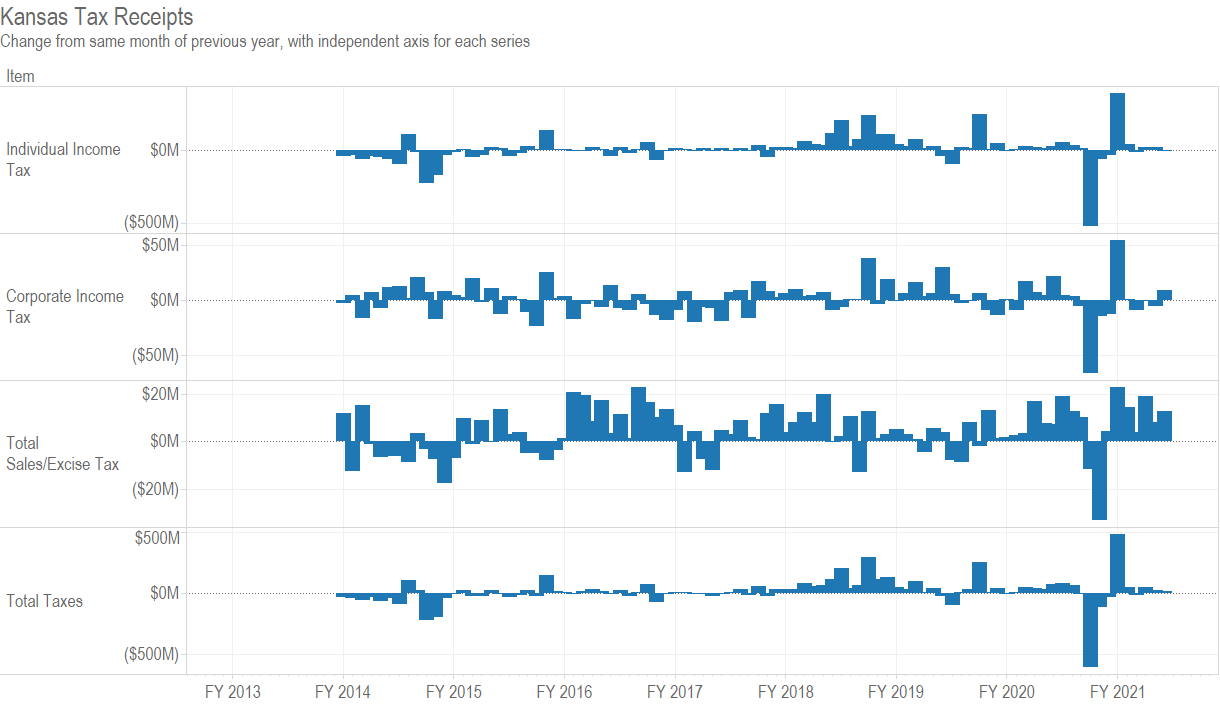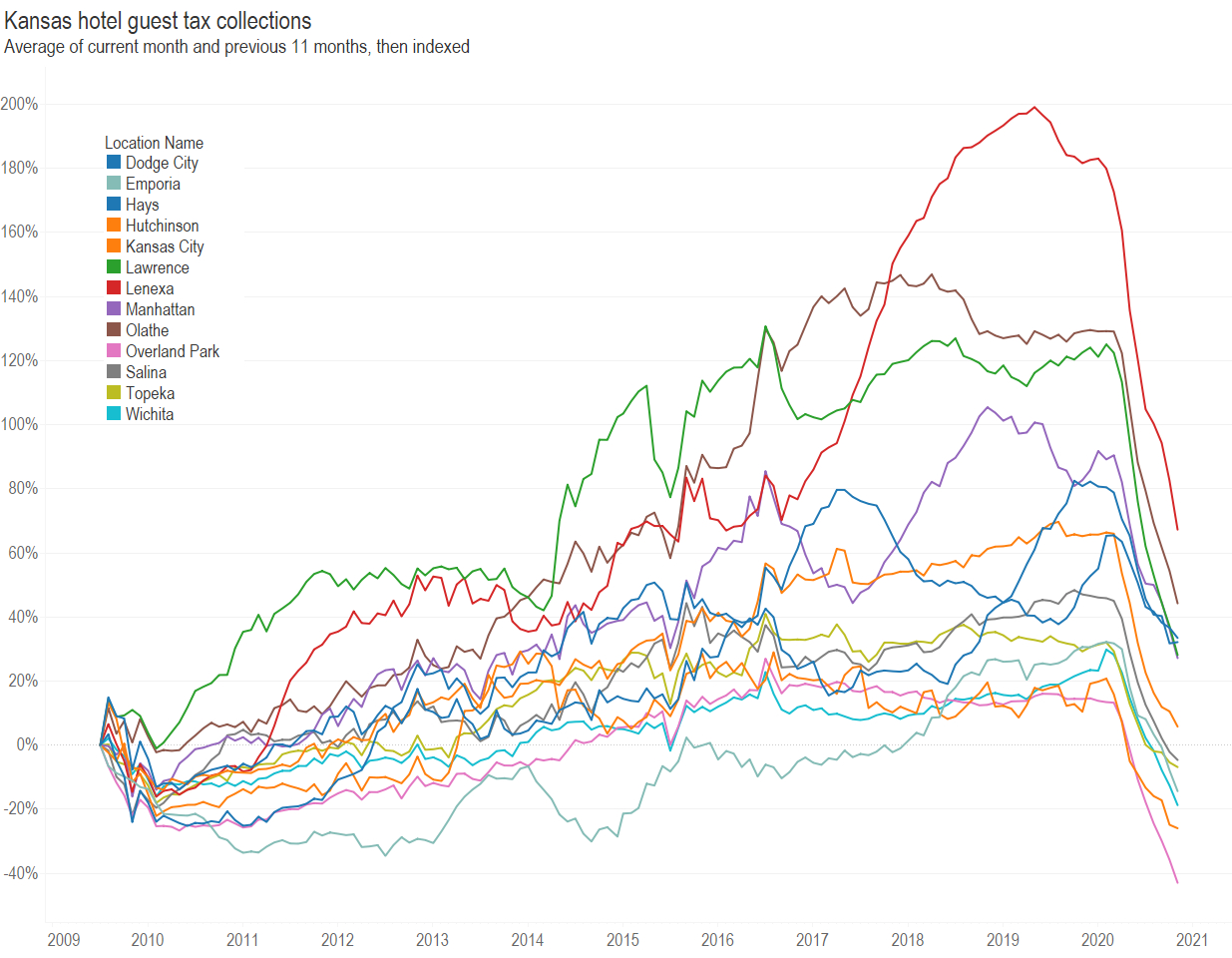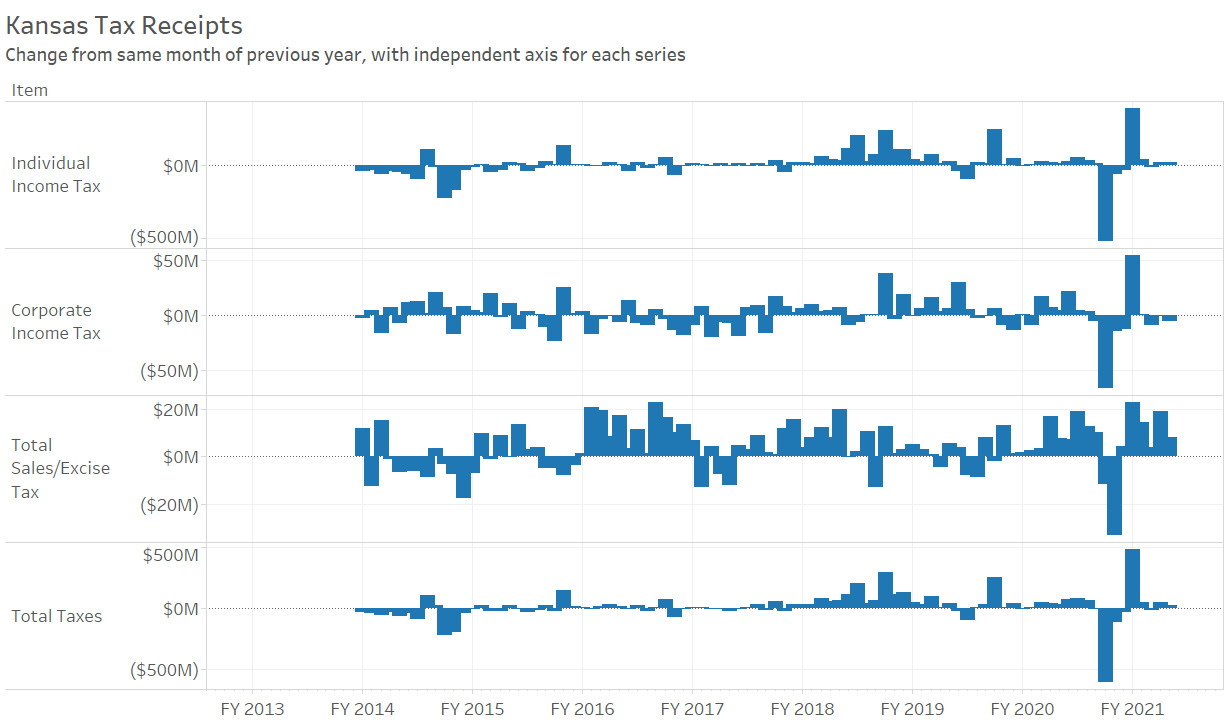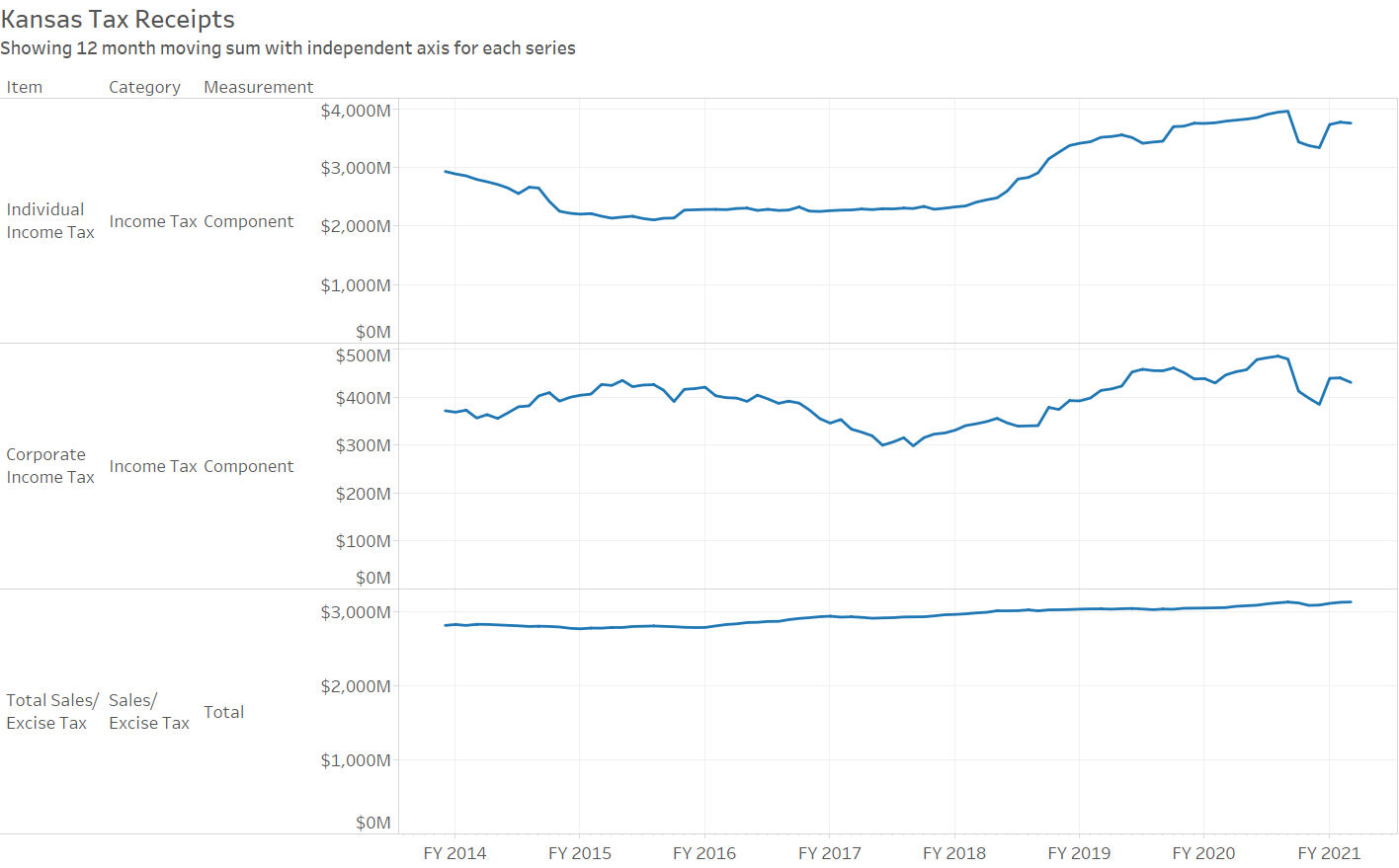For December 2020, total Kansas tax revenue was 1.8 percent greater than last December 2019. Over the six months of the current fiscal year, tax revenue is 16.6 percent higher than at the same point of the previous fiscal year.
Tag: Taxation

Updated: Kansas hotel guest tax collections
Kansas hotel guest tax collections presented in an interactive visualization. Updated with data through November 2020.

Kansas tax revenue, November 2020
For November 2020, total Kansas tax revenue was 4.3 percent greater than last November. Over the five months of the current fiscal year, tax revenue rose by 20.6 percent.
Tax reports from the State of Kansas for November 2020 show tax revenues falling from the previous month, but higher than the same month last year, despite the effects of the response to the pandemic.
When reporting on Kansas tax collections, the comparison is usually made to the estimated collections. Those estimates were revised in April based on economic conditions affected by the response to the pandemic. To get a feel for the effects of the response to the pandemic, it is best to compare to the same month the prior year.
(The estimated revenue figures are still important because the state budget is based on them. If the actual revenue is much below the estimated revenue, there may not be enough income to pay expenses.)
For November 2020, individual income tax collections were $275,431,758, up 9.1 percent from last November. Retail sales tax collections rose by 0.1 percent to $201,705,376. Total tax collections were $556,754,532, up 4.3 percent from the same month last year. A nearby table summarizes.
For fiscal year 2021, which started on July 1, 2020, total tax collections are up by 20.6 percent over the same period of the previous fiscal year. A large reason for this is the change in tax deadlines from April to July, shifting much revenue from fiscal year 2020 to fiscal year 2021. That hasn’t always been explained, as I show in In Kansas, explanations for tax collections may vary.
As can be seen in a nearby table, tax revenue for fiscal year 2021 is $582,301,471 greater than at the same time in the previous fiscal year. Of this, $465,061,221, or 79.9 percent, is due to the increase in individual income tax revenue.
My report on tax revenue for April details some changes made by the estimating group.
My interactive visualization of Kansas tax revenue has been updated with October data. Click here to use it.
An example from the visualization illustrates the composition of Kansas tax revenue for the last year. Individual income tax accounted for 50.5 percent of revenue, and retail sales tax 31.5 percent. Together, this is 82.0 percent. Add compensating use tax of 7.0 percent and corporate income tax of 5.6 percent, and that is nearly all — 94.6 percent — of Kansas tax revenue.

Click for larger. 
Click for larger 
Kansas tax revenue, October 2020
For October 2020, total Kansas tax revenue was 7.9 percent greater than last October. Over the four months of the current fiscal year, tax revenue rose by 24.4 percent.
Tax reports from the State of Kansas for October 2020 show tax revenues falling from the previous month, but higher than the same month last year, despite the effects of the response to the pandemic.
When reporting on Kansas tax collections, the comparison is usually made to the estimated collections. Those estimates were revised in April based on economic conditions affected by the response to the pandemic. To get a feel for the effects of the response to the pandemic, it is best to compare to the same month the prior year.
(The estimated revenue figures are still important because the state budget is based on them. If the actual revenue is much below the estimated revenue, there may not be enough income to pay expenses.)
For October 2020, individual income tax collections were $283,620,667, up 9.1 percent from last October. Retail sales tax collections rose by 5.1 percent to $210,994,242. Total tax collections were $596,567,392, up 7.9 percent from the same month last year. A nearby table summarizes.
For fiscal year 2021, which started July 1, 2020, total tax collections are up by 24.4 percent over the same period of the previous fiscal year. A large reason for this is the change in tax deadlines from April to July, shifting much revenue from fiscal year 2020 to fiscal year 2021. That hasn’t always been explained, as I show in In Kansas, explanations for tax collections may vary.
My report on tax revenue for April details some changes made by the estimating group.
My interactive visualization of Kansas tax revenue has been updated with October data. Click here to use it.

Example from the visualization. Click for larger. 
Kansas tax revenue, September 2020
For September 2020, total Kansas tax revenue fell by 2.0 percent from last September. Over the three months of the current fiscal year, tax revenue rose by 29.7 percent.
Tax reports from the State of Kansas for September 2020 show tax revenues falling from the previous month, and still recovering from the effects of the response to the pandemic.
When reporting on Kansas tax collections, the comparison is usually made to the estimated collections. Those estimates were revised in April based on economic conditions affected by the response to the pandemic. To get a feel for the effects of the response to the pandemic, it is best to compare to the same month the prior year.
For September 2020, individual income tax collections were $358,607,241, down 4.4 percent from last September. Retail sales tax collections fell by 2.5 percent to $195,565,714. Total tax collections were $728,892,761, down 2.0 percent from the same month last year. A nearby table summarizes.
For fiscal year 2021, which started July 1, 2020, total tax collections are up by 29.7 percent over the same period of the previous fiscal year. The press release from the governor’s office noted that the change in tax deadlines is part of the reason for the increase. That hasn’t always been explained, as I show in In Kansas, explanations for tax collections may vary.
My report on tax revenue for April details some changes made by the estimating group.
My interactive visualization of Kansas tax revenue has been updated with August data. Click here to use it.

In Kansas, explanations for tax collections may vary
Kansas officials have explanations for low tax collections, but don’t mention the same contributing factor when touting high collections.
In March, Kansas Governor Laura Kelly, in response to the COVID-10 pandemic, delayed the due date for Kansans to file and pay income taxes from April 15, 2020 to July 15, 2020. 1 This change was bound to affect state tax collections for April, and it did.
When presenting tax collections for the month of April 2020, the Department of Revenue explained: “As predicted, the State of Kansas saw a decrease in total tax collections when compared to April of Fiscal Year 2019. These reductions are largely due to announced tax date extensions, which gave relief to Kansans while moving collections into the Fiscal Year 2021.” 2
Specifically, individual income tax revenue for April 2020 fell by $526 million (65.0 percent) from April 2019. 3 Corporate income tax collections also fell, but caused a much smaller effect. (Over the past five years, individual income tax collections have accounted for about 45.0 percent of total tax collections, while corporate income tax was 6.7 percent of the total.)
For Kansas state government, the fiscal year starts on July 1, and is named for the calendar year in which it ends. Fiscal year 2020, for example, began on July 1, 2019, and ended on June 30, 2020. So not only was a lot of collections shifted from one month to another, the shift also crossed the fiscal year boundary.
When July 2020 tax collections were released, the governor’s office commented:
The State of Kansas starts Fiscal Year 2021 by surpassing its total tax-only collections by $484.6 million compared to July of last fiscal year. …
The State collected $619.6 million in individual income taxes for the month; an increase of $395.3 million, or 176.3%, compared to the July of Fiscal Year 2020. However, these collections were $30.4 million, or 4.7%, less than the estimate for the month. Corporate income tax collections were $69.8 million; $5.2 million, or 6.9%, less than estimated but an increase of $54.6 million compared to July of FY 2020. [Kansas Governor’s office news release, August 4, 2020. Available at https://governor.kansas.gov/kansas-total-tax-collections-484-6-million-ahead-of-july-of-last-fiscal-year/.]
Note there is no mention of why the July income taxes were so much higher than last July. While I have presented only an excerpt of the news release, the remainder does not mention the shift of tax deadlines as the reason for the increase.
When announcing August 2020 tax collections, the governor released this, in part:
The state is $35.6 million, or 2.4%, ahead of projections for the year with $1.5 billion in total tax collections for the fiscal year. When comparing total tax collections over the same timeframe to the previous fiscal year, the State of Kansas is $531.0 million, or 53.5%, ahead of Fiscal Year 2020. [Kansas Governor’s office news release, September 1, 2020. Available at https://governor.kansas.gov/state-of-kansas-tax-collections-40-2-million-above-estimates/.]
Here, the press release touts large revenue growth for the fiscal year. But only two months of the fiscal year have passed, and for one of these, collections benefitted mightily from the shift of tax deadlines. The news release did not mention this as a factor in the fiscal year’s increase in tax collections compared to the previous year.
It is not the case that the governor and state officials are not aware of the effect of shifting tax deadlines on revenue. The governor mentioned the shift in April to explain low collections.
But there was no mention of the same factor when celebrating high collections.
I asked the governor’s office and the Department of Revenue to explain this, but there was no response. Michael Austin, who is Director of the Sandlian Center for Entrepreneurial Government at Kansas Policy Institute, said: “Unfortunately it’s another example the administration is more focused on hiding bad press, than to simply present Kansans with facts and reasonable analysis. With July and August income tax revenues offsetting last year’s decline, it’s clear the tax extension moved revenues from April to July and August.”
The example Austin referred to concerns a chart of COVID-19 data that was presented in an unorthodox manner that bolstered the administration’s positions.
For more on Kansas tax collections, see Kansas tax revenue, August 2020 and my interactive visualization of Kansas tax revenue.
—
Notes- Executive order 20-13. Available at https://governor.kansas.gov/wp-content/uploads/2020/03/EO-20-13-Executed.pdf. ↩
- Kansas Department of Revenue news release, May 1, 2020. Available at https://www.ksrevenue.org/press/2020/pr05012020.html. ↩
- Weeks, Bob. Kansas tax revenue experiences effects of pandemic response. Available at https://wichitaliberty.org/kansas-government/kansas-tax-revenue-experiences-effects-of-pandemic-response/. ↩

Deficit shrank in August, but …
The top takeaway of the Congressional Budget Office Monthly Budget Review for August 2020 is that the deficit for the month is smaller than last August. But there are details.
Sometimes it pays to read the fine print. Otherwise, you may receive a false impression. Here is the monthly budget review for August 2020, which is the eleventh month of fiscal year 2020:
The federal budget deficit in August 2020 was $198 billion, CBO estimates, $3 billion less than the deficit in August of last year. However, that comparison is distorted by shifts in the timing of certain payments in both years that had opposite effects on the August deficit in their respective years.
Because September 1, 2019, fell on a weekend, federal payments totaling about $52 billion were made in August rather than in September of that year (increasing the deficit in August). A similar shift, of $57 billion, occurred this year, but from August into July, reducing the August 2020 deficit. Without those timing shifts, the deficit this August would have been $106 billion (or 72 percent) larger than in the same month last year. Outlays for unemployment compensation contributed significantly to the deficit this August, accounting for about half of the increase in government spending (excluding the timing shifts). (emphasis added)
The full report is at Monthly Budget Review for August 2020.
As can be seen in the nearby chart, the deficit for fiscal year 2020 was tracking closely the deficit for the prior year. Then came spending on the pandemic. (The full report has an interactive version of the chart.)
But duplicating the budgetary performance, deficit-wise, of fiscal 2019 is not a positive accomplishment. As CBO reported earlier: “In fiscal year 2019, which ended on September 30, the federal budget deficit totaled $984 billion — $205 billion more than the shortfall recorded in 2018. The deficit increased to 4.6 percent of the nation’s gross domestic product (GDP) in 2019, up from 3.8 percent in 2018 and 3.5 percent in 2017. As a result, federal debt held by the public rose to 79.2 percent of GDP, up from 77.4 percent at the end of fiscal year 2018.” (emphasis added)

Click for larger. 
Kansas general fund spending and receipts
The Kansas budget is volatile, with rising spending and a large deficit.
Figures from Kansas financial reports show that state spending has risen. Based on that and shifts in revenue flows, deficits are large.
The following tables and charts show actual data through fiscal year 2019. Figures for 2020 are revised estimates, and for 2021, the figures are from the approved budget. The primary source of data is Kansas Comparison Report: The FY 2021 Governor’s Budget Report with Legislative Authorizations. 1
The revised estimate of receipts is $826.9 million less than the estimate from November 2019. The revision takes into account estimates of the effect of the pandemic, while the November estimate was made before the coronavirus was known, at least in the United States.
A large reason for the reduction in estimates of receipts is a change in tax due date: “The individual income tax estimate was decreased by $620.0 million in FY 2020 based on the deferment of $560.0 million in tax year 2019 balance dues and estimated payments that now will not be paid until July 15, 2020.” That effect was noticed in July, when individual income tax receipts were $395.3 million higher than in July 2019. 2
Because of the deferral of so much tax revenue from fiscal years 2020 to 2021, receipts in 2021 are forecast to rise by 5.9 percent.
In the following table, spending increases from the general fund average 4.0 percent per year for 2011 through 2021. For the same period, revenue increases average 3.3 percent.
The deficit of revenue compared to spending in 2020 is slightly over one billion dollars. The state issued a certificate of indebtedness of $900.0 million to compensate. This is a loan that must be repaid by the end of fiscal 2021, which is June 30, 2021.
Click on charts and tables for larger versions.
—
Notes- Kansas Division of the Budget, Kansas Comparison Reports. Available at https://budget.kansas.gov/comparison-reports/. ↩
- Weeks, Bob. Kansas tax revenue, July 2020. Available at https://wichitaliberty.org/kansas-government/kansas-tax-revenue-2020-07/. ↩

Kansas tax revenue, August 2020
For August 2020, total Kansas tax revenue fell by 43 percent from July, reflecting the tax deadline postponement from April to July.
Tax reports from the State of Kansas for August 2020 show tax revenues recovering from the effects of the response to the pandemic.
When reporting on Kansas tax collections, the comparison is usually made to the estimated collections. Those estimates were revised in April based on economic conditions affected by the response to the pandemic. To get a feel for the effects of the response to the pandemic, it is best to compare to the same month the prior year.
For August 2020, individual income tax collections were $270,957,227, up 1.2 percent from last August. Retail sales tax collections rose by 0.9 percent to $207,091,484. Total tax collections were $543,492,901, up 9.3 percent from the same month last year. A nearby table summarizes.
My report on tax revenue for April details some changes made by the estimating group.
My interactive visualization of Kansas tax revenue has been updated with August data. Click here to use it.


























